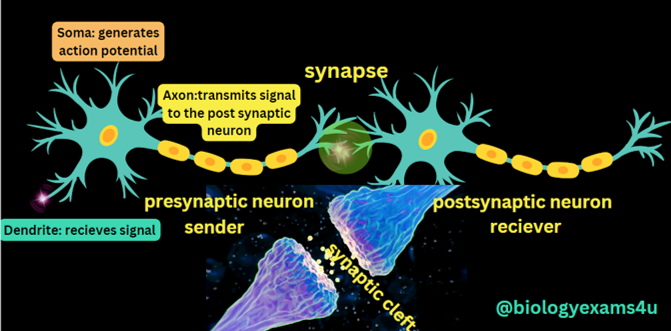How neurons "talk" to each other?
Neurons communicate with each other through electrical and chemical signals. Our brain has approximately 80 billion nerve cells, called neurons. Neurons talk to each other using special chemicals called neurotransmitters. Neurotransmitters are like chemical words, sending “messages” from one neuron to another. Some neurotransmitters may stimulate neurons, called as excitatory neurotransmitters like glutamate, epinephrine, making them more active; others inhibit them, making them less active. Inhibitory neurotransmitters include GABA, glycine and serotonin. Neurons control literally everything we do.
You can watch video on this topic here
A neuron has three
main parts, the cell body, an axon, and the dendrites.
- The cell body or soma has genetic material DNA and other organelles and possess chemical machinery to produce the neurotransmitters that the neuron uses to communicate with each other.
- Dendrites receives signals from other neurons, like antennae.
- An axon carries information as electrical impulse similar to a cable that carries electricity.
What is Synapse?
The communication
junctions between neurons is called synapse. Presynaptic neurons are the “senders”
and post synaptic neurons are the “receivers”.
When one neuron wants to share a message with another, it sends an electrical impulse created by movement of ions, called an action potential. This impulse moves through axon until it reaches the axon terminal, at the end of the axon. Neurons do not physically touch at the synapse, but rather separated by a small gap called Synaptic cleft, where neurotransmitters are released induced by the action potential.
Which are the 6 steps involved in Synaptic Transmission?
Step 1 An action
potential reaches the axon terminal and causes depolarization of presynaptic
membrane.
Step 2 Voltage gated
Calcium ion channels in the presynaptic membrane opens leading to calcium entry
or influx into the presynaptic neuron.
Step 3 Calcium ions
stimulates neurotransmitter containing synaptic vesicles to release their
contents by exocytosis into the synaptic cleft.
Step 4
Neurotransmitters bind with receptors in the postsynaptic membrane.
Step 5 If it is an
excitatory transmitter, sodium ions channels open up and causes depolarization
of postsynaptic membrane generating action potential in the postsynaptic neuron.
Step 6 The
neurotransmitter in the synaptic cleft is removed by enzymatic degradation or
reuptake into the presynaptic terminal.
If it is an inhibitory
transmitter, neurotransmitter combines with the receptors in the postsynaptic
membrane leading to opening of chloride ion channels, which produces
hyperpolarization in the postsynaptic membrane. Thus, impulse transmission
across the synapse is blocked.


